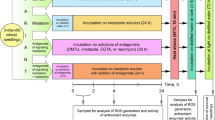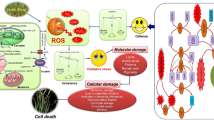Abstract
l-DOPA is an active allelochemical that inhibits plant growth. To determine whether the phytotoxicity is due to the reactive oxygen species generated during its oxidation to melanin, oxidative damage, melanin accumulation, and the effect of antioxidants on its phytotoxicity were examined in l-DOPA-tolerant (barnyard grass) and -susceptible (lettuce) plants, and in suspension-cultured carrot cells. l-DOPA suppressed root elongation in lettuce compared to barnyard grass. Levels of melanin and thiobarbituric acid reactive substances (TBARS) increased remarkably in l-DOPA-treated lettuce roots, but not in barnyard grass. l-DOPA also suppressed carrot cell growth to 60% of the control at 1 mM. Melanin content in 1 mM l-DOPA-treated carrot cells increased continuously; however, ascorbic acid and α-tocopherol suppressed accumulation. When melanin formation was inhibited by ascorbic acid and α-tocopherol, growth of l-DOPA-treated cells was restored. TBARS levels were higher in 1 mM l-DOPA-treated carrot cells than in untreated control cells 2 d after treatment, but not at 4 or 6 d. Ascorbic acid and α-tocopherol suppressed the production of lipid peroxide during the initial 2 d. These results suggest that the phytotoxicity of l-DOPA is due to oxidative stress caused by reactive oxygen species from the melanin synthesis pathway.
Similar content being viewed by others
References
Basma, A. N., Morris, E. J., and Geller, H. M. 1995. l-Dopa cytotoxicity to PC12 cells in culture is via its autoxidation. J. Neurochem. 64:825–832.
Beckman, J. S., Minor, R. I., Jr., White, C. W., Repine, J. E., Rosen, G. M., and Freeman, B. A. 1988. Superoxide dismutase and catalase conjugated to polyethylene glycol increases endothelial enzyme activity and oxidant resistance. J. Biol. Chem. 263:6884–6892.
Bowling, A. C. and Beal, M. F. 1995. Bioenergetic and oxidative stress in neurodegenerative diseases. Life Sci. 56:1151–1171.
Buckley, B. J., Tanswell, A. K., and Freeman, B. A. 1987. Liposome-mediated augmentation of catalase in alveolar type II cells protects against H2O2 injury. J. Appl. Physiol. 63:359–367.
Clement, M.-V., Long, L. H., Ramalingam, J., and Halliwell, B. 2002. The cytotoxicity of dopamine may be an artefact of cell culture. J. Neurochem. 81:414–421.
Dayan, F. E., Romagni, J. G., and Duke, S. O. 2000. Investigating the mode of action of natural phytotoxins. J. Chem. Ecol. 26:2079–2094.
Enochs, W. S., Sarna, T., Zecca, L., Riley, P. A., and Swartz, H. M. 1994. The roles of neuromelanin, binding of metal ions, and oxidative cytotoxicity in the pathogenesis of Parkinson’s disease: A hypothesis. J. Neural. Transm. Park. Dis. Dement. Sect. 7:83–100.
Fujii, Y. 1994. Screening of allelopathic candidates by new specific discrimination and assessment methods for allelopathy, and the identification of l-DOPA as the allelopathic substance from the most promising velvetbean (Mucuna pruriens). Rep. Natl Inst of Agro-Environ. Sci. Jpn 10:115–218 (in Japanese).
Fujii, Y., Shibuya, T., and Yasuda, T. 1991. l-3, 4-Dihydroxyphenylalanine as allelochemical candidate from Mucuna pruriens (L.) DC. var. utilis. Agric. Biol. Chem. 55:617–618.
Greaham, D. G., Tiffany, S. M., Bell, W. R., and Gutknecht, W. F. 1978. Autoxidation versus covalent binding of quinones as the mechanism of toxicity of dopamine, 6-hydroxydopamine, and related compounds toward C1300 neuroblastoma cells in vitro. Mol. Pharmacol. 14:644–653.
Hachinohe, M., Y.Sunohara, H. Matsumoto, (2004). Absorption, translocation and metabolism of l-DOPA in barnyardgrass and lettuce: Their involvement in supecies-selective phytotoxic action. Plant Growth Reg. 43:237–243.
Halbrock, K. and Scheel, D. 1989. Physiology and molecular biology of phenylpropanoid metabolism. Annu. Rev. Plant Physiol. Plant Mol. Biol. 40:347–369.
Haque, M. E., Asanuma, M., Higashi, Y., Miyazaki, I., Tanaka, K., and Ogawa, N. 2003. Apotosis-inducing neurotoxicity of dopamine and its metabolites via reactive quinone generation in neuroblastoma cells. Biochem. Biophys. Acta 1619:39–52.
Kruk, I., Lichszteld, K., Bounias, M., and Kladna, A. 1999. Formation of active oxygen species during autoxidation of DOPA. Chemosphere 39:443–453.
Lai, C. T. and Yu, P. H. 1997. Dopamine- and l-β-Dihydroxyphenylalanine hydrochloride (l-Dopa)-induced cytotoxicity towards catecholaminergic neuroblastoma SH-SY5Y cells. Biochem. Pharmacol. 53:353–372.
Matsumoto, H., Mizutani, M., Yamaguchi, T., and Kadotani, J. 2002. Herbicide pyrazolate causes cessation of carotenoids synthesis in early watergrass by inhibiting 4-hydroxyphenylpyruvate dioxygenase. Weed Biol. Manag. 2:39–45.
Melamed, E., Offen, D., Shirvan, A., Djaldetti, R., Barzilai A., and Ziv, I. 1998. Levodopa toxicity and apotosis. Ann. Neurol. 44:S149–S154.
Nakajima, N., Hiradate, S., and Fujii, Y. 1999. Characteristics of growth inhibitory effect of l-3,4,-dihydroxyphenylalanine (l-DOPA) on cucumber seedlings (in Japanese). J. Weed. Sci. Technol. 44:132–138.
Parsons, P. G. 1985. Modification of DOPA toxicity in human tumour cells. Biochem. Pharmacol. 34:1801–1807.
Pattison, D. I., Dean, R. T., and Davies, M. J. 2002. Oxidation of DNA, proteins and lipids by DOPA, protein-bound DOPA, and related catechol(amine)s. Toxicology 177:23–37.
Peters, S. and Schraermeyer, U. 2001. Characteristics and functions of melanin in retinal pigment epithelium. Der Ophthalmologe 98:1181–1185.
Riley, P. A. 1997. Melanin. Int. J. Biochem. Cell Biol. 29:1235–1239.
Rosenberg, P. A. 1988. Chatecholamine toxicity in cerebral cortex in dissociated cell culture. J. Neurosci. 8:2887–2894.
Smythies, J. R. 1997. Oxidative reaction and schizophrenia: A review-discussion. Schizophr. Res. 24:357–364.
Velikova, V., Yordanov, I., and Edreva, A. 2000. Oxidative stress and some antioxidant systems in acid rain-treated bean plants. Protective role of exogenous polyamines. Plant Sci. 151:59–66.
Wakamatsu, K. and Ito S. 2002. Advanced chemical methods in melanin determination. Pigment Cell Res. 15:174–183.
Warabi, E., Usui, K., Tanaka, Y., and Matsumoto, H. 2001. Resistance of a soybean cell line to oxyfluorfen by overproduction of mitochondrial protoporphyrinogen oxidase. Pest Manag. Sci. 57:743–748.
Author information
Authors and Affiliations
Corresponding author
Rights and permissions
About this article
Cite this article
Hachinohe, M., Matsumoto, H. Involvement of reactive oxygen species generated from melanin synthesis pathway in phytotoxicty of L-Dopa. J Chem Ecol 31, 237–246 (2005). https://doi.org/10.1007/s10886-005-1338-9
Received:
Accepted:
Issue Date:
DOI: https://doi.org/10.1007/s10886-005-1338-9




